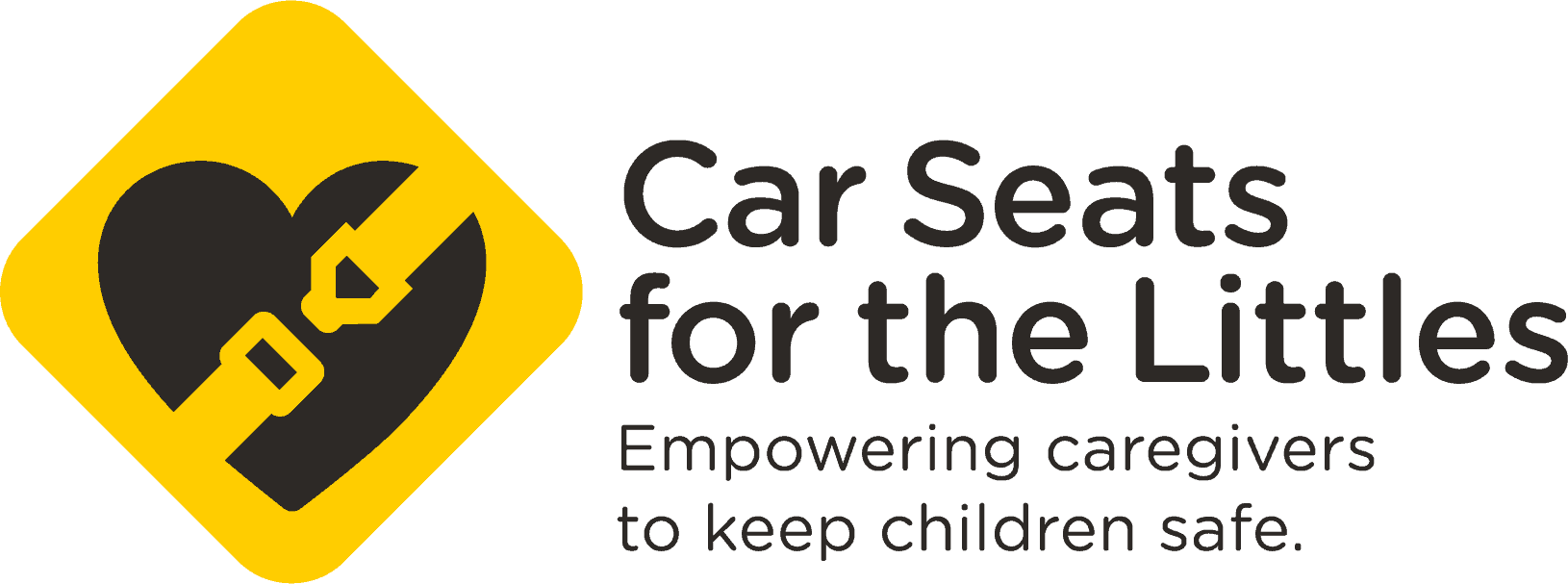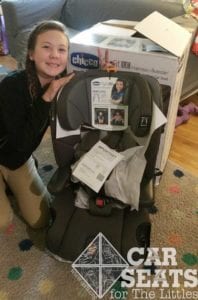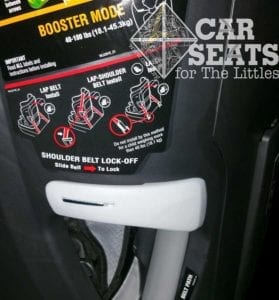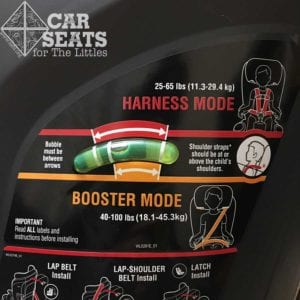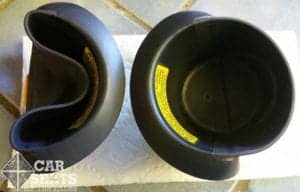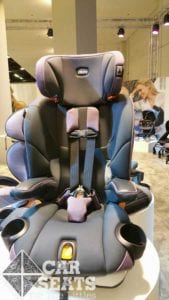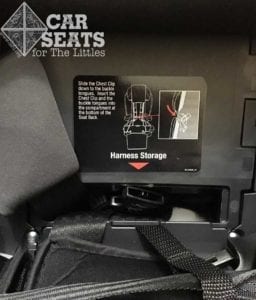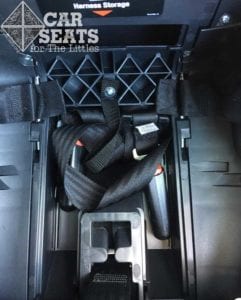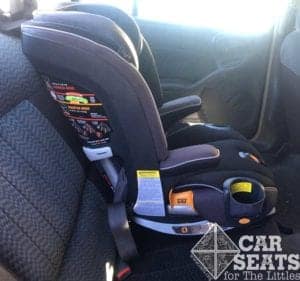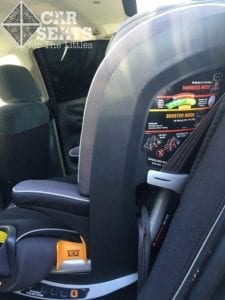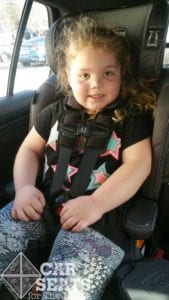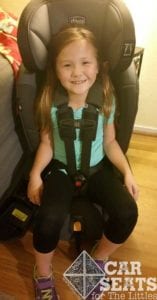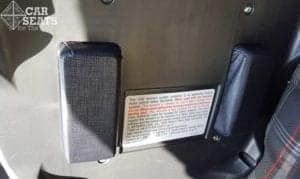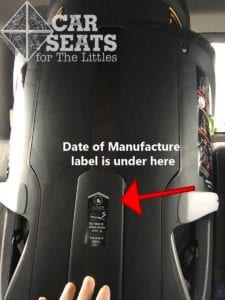Chicco is a name we know well. They’ve brought us the much-loved KeyFit rear facing only car seat, the Fit2 rear facing only car seat, the well-featured NextFit and NextFit iX convertible car seats, the easy-to-use KidFit booster, and the GoFit backless booster that’s a favorite travel option for older children. With all of this awesomeness under their belt, we were kind of beside ourselves when we first met the MyFit Harness+Booster™ combination car seat at the JPMA show in May of 2017. But we kept quiet about the seat because it wasn’t on the market just yet.
Well, the MyFit’s day has finally arrived! There are two trim levels: the MyFit and the MyFit LE. We were lucky enough to spend some time with both models. We’ll note the differences as we go in this review.
CSFTL Quick Stats
- Forward facing weight range: 25-65 pounds
- Forward facing height range: 54 inches or less
- Minimum age requirement: 2 years old CSFTL advocates that children ride rear facing until they’ve outgrown their convertible or multimode car seat.
- Lowest harness position: 13 inches
- Highest harness position: 19.5 inches
- Booster mode weight range: 40-100 pounds CSFTL recommends that children be at least 5 years old before moving to a booster seat.
- Booster mode height range: 38-57 inches tall
- Booster mode highest shoulder belt guide position: 20 inches
- Expiration: 8 years
- Lower anchor weight limit: 40 pounds
Measurements
- Shell height: 26 inches tall with headrest fully extended
- Width at widest point: 17.5 inches
- Width at narrowest portion of the seat pan: 11.5 inches
- Seat weight: 26 pounds
- Upper body internal seating area: 12 inches at the narrowest point, 14 inches further out on the shoulders
Features
- Seat belt lockoffs
- Push button lower anchor connectors
- MyFit LE also includes KidConsole storage console and SuperCinch® LATCH Tightener
- Four recline positions
- Two position crotch buckle
- No rethread harness
- Fold-in cupholders (require assembly)
Unique Features
Love Song to the Lockoff
The MyFit has lockoff devices that are quite similar to the ones that we know and love from Chicco’s NextFit iX convertible car seat. When installing the MyFit with the vehicle seat belt, follow the directions for sliding the shoulder belt into the lockoff. It makes installation a breeze by locking the vehicle seat belt into place.
There are a variety of lockoffs on the market. The MyFit’s lockoff is among our very favorites because it’s so darn easy to use.
Recline Indicator
Most forward facing only car seats don’t have a recline indicator, but the MyFit does. Caregivers who have used Chicco products since their child was born will see the same type of indicator that they’re used to seeing on their NextFit.
The lines on the seat must be parallel with the vehicle seat and the bubble must also be in the proper range. At first glance, that seems like a lot to get right. We were happy to find that it wasn’t too difficult to install the MyFit with the bubble in the correct position.
Cupfolders
Chicco’s innovative cupholders — they call them cupfolders — fold in to make extra space next to the car seat. This fold-in feature can make all the difference when fitting another car seat or passenger next to the MyFit. They also remove easily and are dishwasher safe. When ours got a bit gnarly, I just popped them out, washed them, and put them back onto the seat!
The MyFit ships with cupholder assembly instructions, and the manual has these assembly instructions as well.
Chicco has clarified that the cupfolders are not required to use the seat. Here’s what they said:
As per our instructions the assembly is correct and the purpose of the cup folder is that it can be out of the way when installed and used correctly.
It is to the customers advantage to use it since it will maintain the integrity of the soft goods as well.
Recline Positions
The MyFit has four recline positions. The only restrictions noted in the manual about recline refer to installing the seat when the vehicle is on a sloped road: “If vehicle is on a slope, adjust the seat recline to position 3 or position 4 only.”
Chest Clip Pads
The prototype versions of the MyFit that we met at both the JPMA and ABC Kids shows had only one set of harness pads — the optional, removable shoulder pads. The production version of the seat that we received includes a second set of harness pads. They are very grippy, stiff pads around the chest clip in addition to the shoulder pads. These pads are required for use. We found that these pads made undoing the chest clip a bit challenging for all of our models. This could be a useful feature for families who have children with a fondness for car seat escape attempts.
Because the harness and the chest clip pads remain attached to the seat at all times, we worry that these chest clip pads could get quite dirty over time. Or in a hurry if there’s a vomit incident.
Harness Storage
The harness remains attached to the seat when it’s in booster mode. To convert the MyFit from harness to booster mode, the short version of this process is: loosen the harness all the way, then tuck the webbing into the handy compartment behind the cover. The crotch buckle stores under the cover on the seat pan. We prefer this storage method because it prevents the harness or other parts from getting lost.
The harness pads and padded waist pads do have to come off of the harness, they don’t store on the seat itself.
Seating Area Width
The seating area is 11.5 inches wide at the narrowest point. This is fairly narrow for a combination seat, but none of our models complained that the MyFit felt cramped to them. Frankly, we were kind of surprised that they didn’t complain because the seating area appears small to our adult eyes.
Important Use Rules
Inflatable Seat Belts — Not Allowed in Harness Mode
The MyFit cannot be installed with an inflatable seat belt when it’s in harness mode. If it must be installed in a seating position with an inflatable seat belt, lower anchors plus the top tether would be the only acceptable installation method, assuming that the child weighs less than the 40 pound lower anchor weight limit.
Inflatable Seat Belts — Allowed in Booster Mode
In booster mode ONLY, the MyFit can be used with inflatable seat belts if the vehicle manual permits it.
Age 2 and 25 Pound Minimum
We were thrilled to see that the MyFit manual stipulates that the child must be 2 years old to use the seat in harness mode. We always recommend waiting longer to forward face if possible, but age 2 is the minimum for safety. We would have been happier had this restriction also been on the labels on the seat itself! The MyFit also cannot be used for a child weighing under 25 pounds, which differs from other combination seats which can be used from 22 pounds.
Crotch Buckle
The manual states that the crotch buckle can’t be under the child. Chicco has clarified that this means the child can sit on top of the webbing a little bit — it’s more about comfort and fit.
Vehicle Head Restraint
The manuals prohibit leaving a gap between the MyFit’s back and the vehicle seat. This gap usually happens when the vehicle’s head restraint pushes the car seat out and away from the vehicle seat. The manual recommends removing the vehicle head restraint or moving the MyFit to a different seating location.
Challenges
Shake, Rattle, and Roll
The MyFit LE includes the KidConsole, which is a square container that slips into the cupholder. My daughter loves the handy container but we found that it rattles quite a bit and the console itself tends to slip out of the cupholder. We experimented with pushing it further into the cupholder but couldn’t quite find a spot that didn’t rattle or slip out of place.
In addition to the rattling from the KidConsole, while riding in booster mode my kiddo reported that it sounds like something is popping in the headrest. That something seems to be the foam padding in the headrest rubbing against the seat’s shell. The LATCH system is optional for booster mode — without it, it’s important to buckle the seat when it’s not in use. I installed the seat using LATCH and that seemed to lessen the noise.
Installation
Lower Anchors
The MyFit LE includes Chicco’s SuperCinch LATCH Tightener. This system is the same one we liked on the NextFit iX so I was excited to see it in use on the MyFit as well. The biggest trick is to pull slightly more of the webbing from Side 1 than I expected to, then pull Side 2.
Lower Anchor Storage
When they’re not in use, the lower anchors store under the seating area in a handy compartment.
Vehicle Seat Belt
Lap Only Seat Belt
Lap only vehicle seat belts are kind of rare things these days, so when we get a chance to review a car seat that we can install using this type of seat belt and top tether, we want to tell you all about it! We were able to achieve a solid installation by reaching through the gap in the front of the cover to pull across the seat belt along the belt path while pushing the MyFit back toward the vehicle seat back.
Lap/Shoulder Seat Belt
The MyFit includes the updated lockoffs we’ve come to know and love on the NextFit iX. Installing the MyFit with a lap/shoulder vehicle seat belt was fairly painless. Like many combination car seats, the belt path is high and somewhat narrow. This configuration often means that the best way to achieve a solid installation is to push the car seat back toward the vehicle seat back while pulling the vehicle seat belt snug.
We were a little worried that the lockoff would make this technique a bit of a challenge since the lockoff is on the outside of the MyFit. However, we didn’t need to work too terribly hard to install the MyFit! These steps made for a secure install without too much trouble: push down on the MyFit, then pull the vehicle seat belt directly up. The final step was to slide the vehicle seat belt into the lockoff.
Pro Tip for vehicle seat belt installation: if you can’t get the MyFit installed with less than 1 inch of movement at the belt path, rock the MyFit side to side while keeping the vehicle seat belt snug just a bit as you finish tightening the vehicle seat belt to remove the extra slack from the belt. We found this technique helped a lot in vehicles with non-removable head restraints.
Belt Path Access
We’re big fans of moving a car seat’s cover out of the way to access the belt path. We found that the portion of the MyFit’s cover behind the child’s back was a bit obstructive — it’s so firm and padded that it took a little effort to get it out of the way.
Harness Adjustment
The MyFit’s harness adjusts with the same silky smooth goodness that we’ve come to expect from Chicco’s car seats. There’s no struggle to release or tighten the harness correctly. Harness adjustment is a critical piece of achieving a custom fit on every ride so we definitely applause this ease of use feature!
Fit to Child
Four Years Old
This little cutie is 4.5 years old. At 58 pounds and 45 inches tall, she’s at the top end of the growth chart. She fit into the seat but wasn’t particularly comfortable. While the MyFit worked well for our models on the lower end of the growth curve, it wasn’t such a great fit for this kiddo.
Eight Years Old
This model is 8 years old. She weighs 64 pounds and is 52 inches tall. She’s a mere one pound from the maximum weight limit for the MyFit but we were pleasantly surprised to see that she fits into the harness!
Converting to Booster Mode
Over the years, I’ve found myself converting an almost embarrassingly large number of combination and multimode car seats from harness mode to booster mode, all for the sake of making our readers’ lives easier. On a scale of easy to hard, with the easiest conversion being the Graco Milestone (I did not write our review of the 4Ever; I do think that is easier to convert!) and the hardest being the Evenflo SafeMax, converting the MyFit to booster mode is a lot like converting the Britax Frontier. Aka, the MyFit falls somewhere in the middle of the difficulty/annoyance scale.
The manual lists 15 steps to make the conversion. The process involves removing an entire piece of the cover, removing some elastic loops that attach the cover to the seat’s shell in the process. Normally, I find elastic loops a real challenge but the loops on the MyFit attach to accessible spots on the seat’s shell so getting them on and off wasn’t too difficult. The bottom portion of the cover unsnaps from the armests to expose the belt path for harness storage. The harness and the crotch buckle both store on the seat itself. The only pieces that come off are the shoulder pads and the hip pads for the harness. In other words, you can’t misplace the harness but you could misplace those pads.
Thirteen Minutes — Now Eight!
This is how long it took me to convert the MyFit from booster mode back to harness mode, then install it on the side of the road while my daughter climbed around in our parked car, asking question after question about what I was doing. I have, over the years, converted more than my fair share of car seats from harness mode to booster mode so I can only imagine how long this task would take caregivers who don’t spend this kind of time with car seats. I’d put this timeframe on the high end of those conversions.
Most families make this conversion one time, possibly twice — when the kiddo outgrows the seat in harness mode or when preparing the seat for a younger sibling. I tend to go back and forth between modes a number of times over the course of a review so take my thirteen minutes with a grain of salt.
A few months later and my MyFit has seen steady use. I’m now able to make this same conversion in eight minutes so don’t despair!
Harness Storage
When I first met the MyFit at JPMA last year, I mentioned that the open harness storage compartment would be a problem because children could feel the gap behind their backs. The version of this compartment that’s currently in production is smoother than the original version but sure enough, the moment my daughter got into the MyFit, she complained about this compartment. With all of my heart, I wish that there was a smooth plastic cover over this compartment.
However, my model did seem to get used to it over time. And none of our other models had anything to say about it so it’s possible that most kiddos wouldn’t find it an issue.
LATCH in Booster Mode
The MyFit allows the use of lower anchors and top tether in booster mode to secure the seat to the vehicle when the child isn’t in the seat.
The manual includes this slightly confusing phrase: “If LATCH and or Tether is not used, make sure the LATCH Straps are properly stored.” When we asked Chicco for clarification around this, here’s their reply: Because it is not addressed in the manual the basic recommendation is if LATCH isn’t available in a seating position store both the lower anchors and the tether.”
Fit to Child
Booster Mode
Seven Years Old
Here we see a 7 year old model. She weighs 80 pounds and is 53 inches tall. She is well within the stated limits, and was able to get into the MyFit without issue, but she’s quite cramped in it. This would not be my first choice for a child on the higher end of the growth curve.
Eight Years Old
Once again, our 8 year old model is ready to show how the seat fits. She’s still 64 pounds and 52 inches tall, or in the 75th percentile for height and weight. She’s on the top headrest setting for booster mode so she doesn’t have a lot of room to grow in this seat. This is about what we expect from a combination car seat — they tend to be short-lived as a booster to help children adjust to booster riding in a seat they already know rather than a long-lasting booster option.
For the most part, she finds it comfortable and she’s able to buckle herself in without issue thanks to the sloped side of the MyFit’s base. After a couple weeks of riding in the MyFit, she’s informed us that she likes it as much as she liked her very beloved (and long outgrown) Graco Contender. That’s high praise, indeed!
Months later and this model liked the MyFit so much, it’s become her primary booster. She says the plush cover and high comfort level can’t be beat!
Seat Belt Retraction Issues?
We are always watching, always looking to see if the combination car seats and booster seats we review have issues with allowing the vehicle seat belt to retract as the child moves around. During our extensive test of the MyFit in booster mode, we encountered zero issues when the bottom of the headrest was above the seat’s shell. The vehicle seat belt moved freely through the belt guide and never once slipped out.
We did encounter a few issues when the headrest was below the shell but that’s pretty typical for a combination car seat. If the child rides in harness mode until they’ve outgrown the MyFit’s harness by height or weight, then moves to booster mode, this shouldn’t be an issue.
Travel
The MyFit is approved for use on aircraft in harness mode. At 17.5 inches across, it’s likely to fit well on the airplane’s seat but getting it onto the plane would require quite a bit of sweat equity. The MyFit weighs 26 pounds — that’s a lot of weight for a travel seat! It may well be worth the effort for families who can install the MyFit without trouble or for families who don’t mind lugging a heavier, full-featured seat through the airport.
Three Across — Two Car Seats and One Passenger
The MyFit is pretty darn narrow — just 17.5 inches wide at the widest part of the seat. We suspect that this will make it a solid option for situations with more than one car seat in a row. I put the MyFit to the test as much as my reviewmobile — a 2016 VW GTI– will allow. That’s 2 car seats or booster seats and one passenger who does not ride in a car seat or booster seat.
Thanks to an unexpected playdate, I drove the MyFit, a 9 year old (riding in a Safe Traffic Systems Delighter booster seat), and my 11 year old who passes the Five Step Test. While the 11 year old in the middle wasn’t thrilled to be in the middle of two singing younger kids, they did all fit.
The MyFit has a slope on the sides of the base that makes buckle access pretty simple, even in tight spaces like my car. I give that extra slope at the bottom of the MyFit a lot of credit for making this particular configuration of three passengers work. We will continue to expand our research to include more configurations of 3 across and will update this review as we go.
Important Information: Where to Find
FAA Approval Label: the MyFit is approved for use on aircraft in harness mode. The FAA approval label is found on the bottom of the seat.
Manual Storage: the manual stores in a little pocket under the front of the seat.
Date of Manufacture Label: the date of manufacture label is hiding under the top tether storage compartment.
Overall Thoughts
The MyFit has a lot to offer for some specific situations (and general ones, too!): families who need three car seats across or other narrow situations, families who love the Chicco product line and want to continue purchasing their car seats as the child grows, and families who have a tall, yet slender older child who needs to ride in a harnessed car seat for an extended period.
It also worked wonderfully for our booster riders, making it a long-lasting option for families looking to use the seat first in harness mode, then transition into a well-fitting booster mode. The MyFit brings all of the features that we’ve come to expect from Chicco into their first forward facing only combination car seat that works well in both harness and booster mode.
